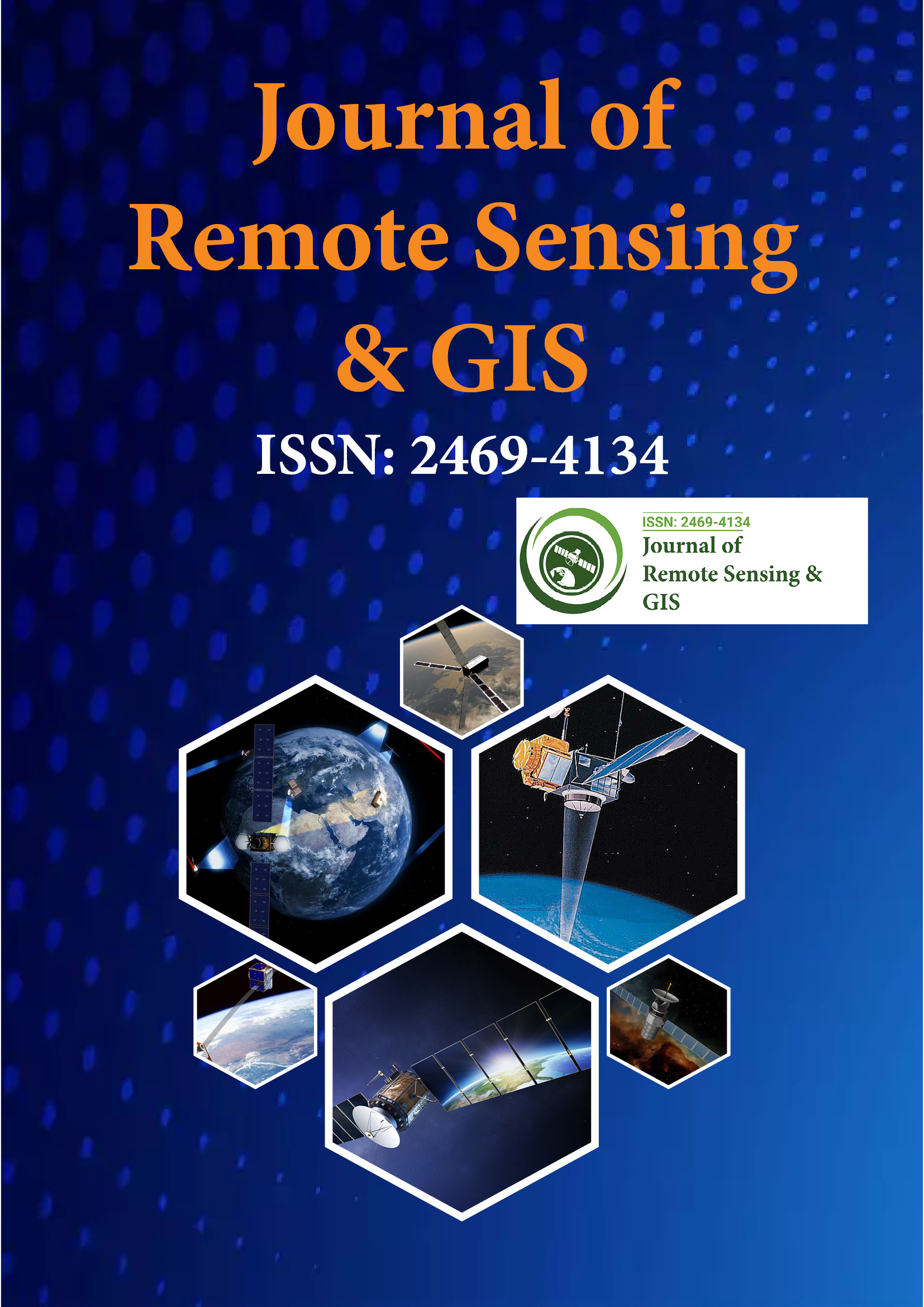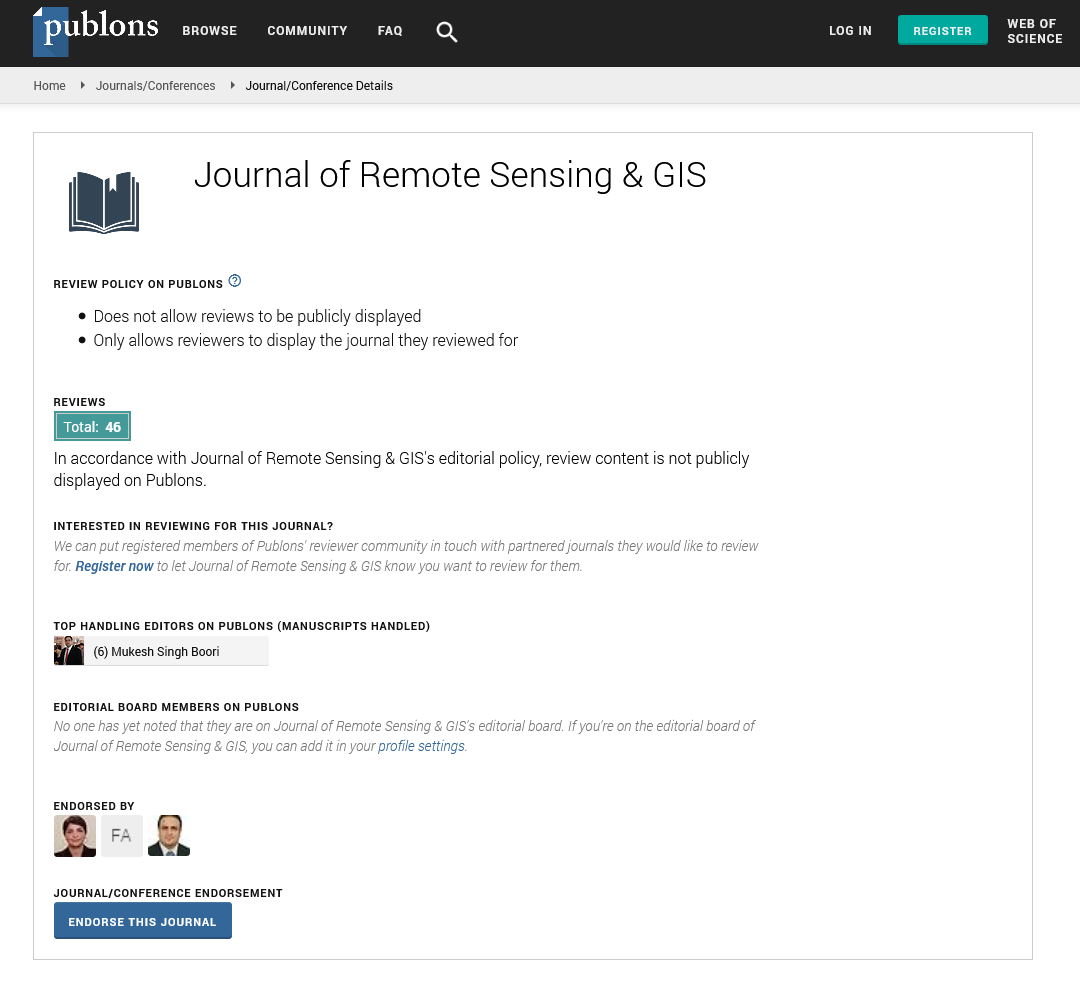Indexed In
- Open J Gate
- RefSeek
- Hamdard University
- EBSCO A-Z
- OCLC- WorldCat
- Publons
- International Scientific Indexing
- Euro Pub
- Google Scholar
Useful Links
Share This Page
Journal Flyer

Open Access Journals
- Agri and Aquaculture
- Biochemistry
- Bioinformatics & Systems Biology
- Business & Management
- Chemistry
- Clinical Sciences
- Engineering
- Food & Nutrition
- General Science
- Genetics & Molecular Biology
- Immunology & Microbiology
- Medical Sciences
- Neuroscience & Psychology
- Nursing & Health Care
- Pharmaceutical Sciences
Commentary - (2025) Volume 14, Issue 1
Exploring the Capabilities of Advanced Remote Sensing Technologies in Landscape Analysis and Change Detection
Stephen Philips*Received: 25-Feb-2025, Manuscript No. JGRS-25-28684; Editor assigned: 27-Feb-2025, Pre QC No. JGRS-25-28684 (PQ); Reviewed: 14-Mar-2025, QC No. JGRS-25-28684; Revised: 21-Mar-2025, Manuscript No. JGRS-25-28684 (R); Published: 28-Mar-2025, DOI: 10.35248/2469-4134.25.14.370
Description
Remote sensing has become an essential component of environmental monitoring, resource management, urban planning and disaster assessment. With advances in sensor technology, data processing and computational capacity, remote sensing has evolved beyond traditional image capture to provide more accurate, timely and detailed information across multiple scales.
Modern remote sensing systems include a range of satellite and airborne platforms equipped with advanced sensors capable of detecting radiation across different portions of the electromagnetic spectrum. These systems provide high-resolution imagery and diverse data types, which can be used to monitor dynamic changes on the Earth's surface. As technology continues to evolve, new applications are emerging in areas such as agriculture, forestry, hydrology and climate science.
Sensor technology development
Advancements in sensor technology have significantly improved data collection. Traditional passive optical sensors, which rely on sunlight to detect reflected energy, have been supplemented by active sensors such as Synthetic Aperture Radar (SAR) and Light Detection and Ranging (LiDAR). These systems can operate regardless of weather conditions or lighting, greatly expanding the applicability of remote sensing.
Hyperspectral sensors: These sensors capture data across hundreds of narrow spectral bands, allowing for precise identification of surface materials based on their spectral signatures. Applications include mineral exploration, vegetation health monitoring and pollution detection.
LiDAR: LiDAR systems emit laser pulses and measure the time it takes for the reflected light to return, enabling the construction of detailed 3D models of terrain and vegetation. This technology is widely used in forest inventory, flood modeling and urban development.
Synthetic Aperture Radar (SAR): SAR sensors emit microwave signals and record their reflections from the ground surface. They can penetrate cloud cover and are useful for monitoring land deformation, ice movement and infrastructure changes.
High-resolution imaging
High-resolution satellites such as WorldView, Pleiades and GeoEye offer spatial resolutions of less than one meter. This allows for detailed mapping of urban infrastructure, crop fields and coastal zones. Improved temporal resolution, with satellites revisiting the same area more frequently, enables the detection of rapid changes such as deforestation, land use transitions and post-disaster impacts.
Time-series data from these platforms can be used to analyze trends, identify anomalies and support decision-making in sectors such as agriculture, water resource management and disaster response.
Data integration and analysis
The integration of remote sensing data with Geographic Information Systems (GIS) and other spatial tools has expanded analytical capabilities. Spatial data from multiple sources can now be combined to create comprehensive models of land use, topography, vegetation cover and hydrological systems.
Artificial Intelligence (AI) and Machine Learning (ML): These technologies are increasingly used to analyze large datasets from remote sensing. Algorithms can classify land cover, detect patterns and predict environmental changes. For example, AI models are used to automate crop type classification and detect forest degradation.
Cloud computing platforms: Tools like Google Earth Engine enable real-time processing of remote sensing data on a global scale. These platforms allow users to access and analyze petabytes of satellite imagery without the need for local storage or computing power.
Environmental and agricultural applications
In agriculture, remote sensing supports precision farming practices by monitoring crop conditions, soil moisture and nutrient status. Spectral indices such as NDVI (Normalized Difference Vegetation Index) and EVI (Enhanced Vegetation Index) are commonly used to assess vegetation health and estimate yields.
In environmental monitoring, remote sensing provides data for tracking deforestation, wetland loss and changes in snow and ice cover. It plays an important role in assessing the impacts of climate variability and informing conservation strategies.
Disaster assessment and risk management
Remote sensing is extensively used in disaster preparedness and response. After natural disasters such as earthquakes, floods and wildfires, satellite imagery helps assess damage, identify affected areas and plan emergency response.
SAR and LiDAR technologies are particularly useful in mapping flood extent, detecting ground subsidence and evaluating landslide risk. Real-time data allows authorities to respond more effectively and allocate resources where they are most needed.
Urban and infrastructure monitoring
Urban expansion and infrastructure development are closely monitored through high-resolution remote sensing. Urban planners use this data to analyze population density, transportation networks and land use changes. 3D city models generated using LiDAR and stereo imagery support the planning of utilities, traffic management and construction projects. They also help monitor environmental impacts, such as heat island effects and loss of green spaces.
Climate and hydrological studies
Advanced remote sensing provides long-term climate data essential for understanding global change. In hydrology, remote sensing supports the monitoring of surface water bodies, groundwater depletion and glacier retreat. Microwave and thermal sensors contribute to the estimation of soil moisture and snow cover, aiding in drought prediction and water resource planning.
Conclusion
The development of advanced remote sensing technologies has significantly expanded the range and depth of applications in earth observation. With continued innovation in sensors, data processing and AI-driven analysis, remote sensing is positioned to address complex environmental and societal challenges. By providing timely, accurate and multidimensional information, these technologies enhance our ability to observe, understand and manage natural and human systems more effectively.
Citation: Philips S (2025) Exploring the Capabilities of Advanced Remote Sensing Technologies in Landscape Analysis and Change Detection. J Remote Sens GIS.14:370.
Copyright: © 2025 Philips S. This is an open-access article distributed under the terms of the Creative Commons Attribution License, which permits unrestricted use, distribution and reproduction in any medium, provided the original author and source are credited.

